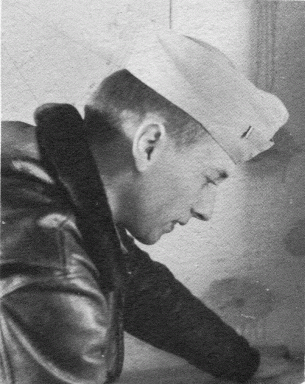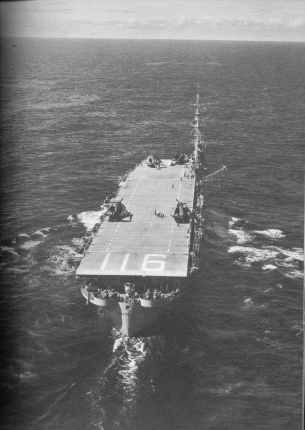
ENS James W. Kinnear
(from Oriental Journey, 1951-1952 Cruise Book)
James W. Kinnear was born in Pittsburgh, PA, on March 21, 1928. He graduated with distinction from the United States Naval Academy in 1950 with a Bachelor of Science degree. For his service during the Korean War, he was awarded seven engagement stars and a Navy Commendation Medal for leading a life-saving detail. In 1954, following the war, James W. Kinnear joined the oil industry.
 ENS James W. Kinnear (from Oriental Journey, 1951-1952 Cruise Book) |
I joined USS Badoeng Strait (CVE-116) the end of June 1950. The Korean War had started on June 25, so we left about 4 July for Korea, with the planes of VMF-323 and VMF(N)-513 (Note 1) on board, in company with the USS Sicily (CVE-118). Captain John (Jimmy) Thach was her CO. East of Kobe we were refueling and had a minor collision with the Gunston Hall (LSD-5) so we put into Kobe for repairs to the forward starboard section of the flight deck. It was strange for a lot of the crew, WW 2 veterans, to be ashore in Japan. The shipyard did a good job, with their scaffolding made of bamboo and rope, but they were good welders. We proceeded to the Tsushima Strait, and started combat strikes about 25 July. Our first General Quarters marked the appearance of a North Korean Yak aircraft which did no damage.
We had put VMF(N)-513 ashore at Atsugi, so we had VMF-323 aboard and the Sicily had VMF-214. These were the first close air support aircraft in Korea, and without them, the US forces would have been pushed off the peninsula. For this we were awarded the Navy Unit Citation. We flew continuous strikes, using a lot of ammunition. Sometimes we were resupplied at sea. We went to Inchon in early September and flew air cover for the invasion on 15 Sept. and thereafter.
Then in November, the Chinese entered the conflict, and we were pushed back. On Christmas Day, 1950, we were offshore Hung-nam covering the withdrawal from the Chosin Reservoir. It was very cold and snowing, and we replenished our ammo and refueled at sea.
Our close air support operations continued until we returned to CONUS in March. The CO's for this cruise were CAPT A.W. McKechnie and CAPT John Alderman. We put the ship in the yard in Bremerton, Washington in May. On Memorial Day, I was assigned to lead a platoon of sailors in a march down main street. Sailors are not very good marchers, but I did my best.
We went back to Korea in October 1951, with VMF-212 aboard. VMF-323 is a regular Marine squadron, and VMF-212 were reservists who had been called back to active duty. Off Okinawa, we encountered a typhoon, and a crewman was washed overboard from the flight deck. We could not launch a whaleboat due to the high seas, but our helicopter got in the air, and, somehow, found the crewman and rescued him.
 USS Badoeng Strait (CVE-116) underway (from Oriental Journey, 1951-1952 Cruise Book) |
We had three pilots killed by enemy action, Capt. Schwartz, Capt. Nadelhofer, and Sgt. Moses. CAPT John Alderman succeeded CAPT McKechnie. CAPT Alderman had a very loud voice and loved to yell "Two block Fox" at the top of it to commence air operations.
Most of this cruise was as a part of TG 96.8 on the West Coast of North Korea. RADM Ruble was on board as Task Group Commander. CAPT Dietrich was his Chief of Staff.
We were briefly part of the Taiwan patrol, but most of the time was spent in Korea. CAPT Roy L. Johnson had relieved CAPT Alderman. I played a lot of golf with CAPT Johnson when we were in CONUS and had also become the senior watch officer, so I saw lot of him. When I took my leave from the ship, he gave me a wonderful compliment "Jimmy, I always slept better when you had the watch!"
We came back to the US in June, and I was immediately transferred to LST-516 and returned to Korea for my third tour which lasted about a year.
The Badoeng Strait was a great ship, flight deck of 500 feet, 550 feet overall, arresting gear and barriers and no slant deck. We never had a fatal accident on board. It got exciting when a combat strike returned with a 5" HVAR which had failed to launch still mounted under the wing. They would dislodge on landing and careen up the deck where we rigged cargo nets to stop them, and then throw them over the side, where they sometimes exploded. Every combat strike was catapult launched. The starboard catapult was 75' and the port one 90'. Launching a F4U-4B with a 2,000 pound bomb load was no easy task. Many of the bombs were napalm tanks. Napalm is made from gasoline and jelly in a disposable tank with an igniter. We mixed it on the hangar deck and why we never blew ourselves up, I shall never know.
We had 500# bombs, 1000# bombs, napalm tanks, 5" HVAR's and .50 caliber machine guns for armament.
These are a few of my memories from nearly 60 years ago.
James W. Kinnear
October 13, 2006
Note 1: VMF(N)-513, "Flying Nightmares," was part of Marine Air Group 33 (MAG-33) and, after arriving in Korea, was land-based under the Fifth Air Force. (Thanks to Captain Adrian L.K. "Kalani" O'Sullivan, USAF [Ret.]).
| Main Photo Index Page |
Escort Carrier Photo Index Page |
USS Badoeng Strait (CVE-116) Main Page |
Comments, Suggestions or Image submissions, E-mail Carrier Information
Problems and site related matters, E-mail Webmaster
This page was created and is maintained by Fabio Peña
![]()
Last update: 18 May 2008